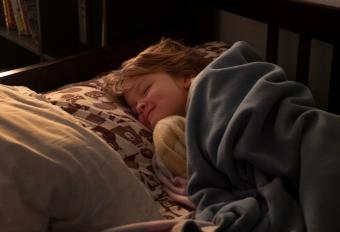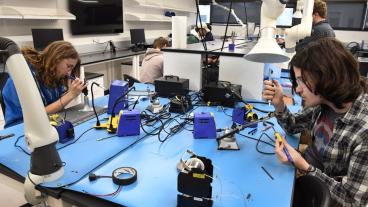Can exposure to even dim light before bedtime disrupt your preschooler’s sleep? A new Mines-connected study suggests yes.
Cecilia Diniz Behn, associate professor of applied math and statistics, contributed to paper recently published in the Journal of Pineal Research

A young study participant tries to get some sleep. Recent research from Colorado School of Mines and CU Boulder suggested that even dim light exposure in the hour before bedtime can disrupt sleep in preschool-age children. (Photo credit: Casey Cass/CU Boulder)
Applied mathematics and statistics researchers at Colorado School of Mines contributed to a new study that showed even slight exposure to light can prompt the critical sleep-promoting hormone melatonin to plummet in preschoolers in the hour before bedtime – potentially disrupting slumber long after the light goes out.

Cecilia Diniz Behn, associate professor of applied mathematics and statistics, and Mines alum Nora Stack PhD ‘19 were co-authors on the study, led by researchers at University of Colorado Boulder and published earlier this month in the Journal of Pineal Research.
“Mathematical modeling has been very important overall for understanding properties of the human circadian clock and its interactions with sleep/wake behavior,” said Diniz Behn, a long-time collaborator of Monique LeBourgeois, associate professor of integrative physiology at CU Boulder and the study’s senior author.
For the new study, researchers enlisted 36 healthy children, ages 3 to 5 years, for a nine-day protocol in which they wore a wrist monitor that tracked their sleep and light exposure. For seven days, parents kept the children on a stable sleep schedule to normalize their body clocks and settle them into a pattern in which their melatonin levels rose at about the same time each evening.
On the eighth day, researchers transformed the children’s home into what they playfully described as a “cave”—with black plastic on the windows and lights dimmed—and took saliva samples every half hour starting in the early afternoon until after bedtime. This enabled the scientists to get a baseline of when the children’s biological night naturally began and what their melatonin levels were.
On the last day of the study, the young study subjects were asked to play games on a light table in the hour before bedtime, a posture similar to a person looking at a glowing phone or tablet. Light intensity varied between individual children, ranging from 5 lux to 5,000 lux. (One lux is defined as the light from a candle 1 meter, or about 3 feet, away).
When compared to the previous night with minimal light, melatonin was suppressed anywhere from 70 percent to 99 percent in the presence of light. Surprisingly, the researchers found little-to-no relationship between how bright the light was and how much the key sleep hormone was suppressed. In adults, this intensity-dependent response has been well documented.
The math team expected to model the illuminance-dependence of the melatonin suppression response, but the suppression in children was so high to light that standard descriptions of illuminance-dependence of melatonin suppression that have been developed in adults were not applicable, Diniz Behn said.
Even in response to light measured at 5 to 40 lux, which is much dimmer than typical room light, melatonin was suppressed an average of 78 percent. And even 50 minutes after the light extinguished, melatonin levels were significantly lower than they were on the previous night in most children tested.
“In this study, our team at Mines used mathematical modeling of the human circadian pacemaker to guide the experimental design, we led the data analysis effort, and we extracted and analyzed light history data to explore possible confounding effects,” Diniz Behn said. “This is a great example of interdisciplinary research in action.”
Read more about the research on CU Boulder Today at https://www.colorado.edu/today/2022/01/25/even-minor-exposure-light-bedtime-may-disrupt-preschoolers-sleep.




